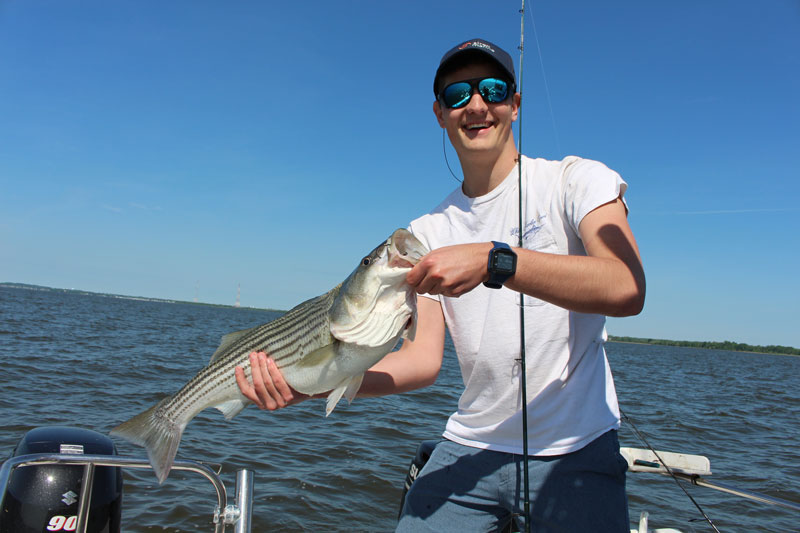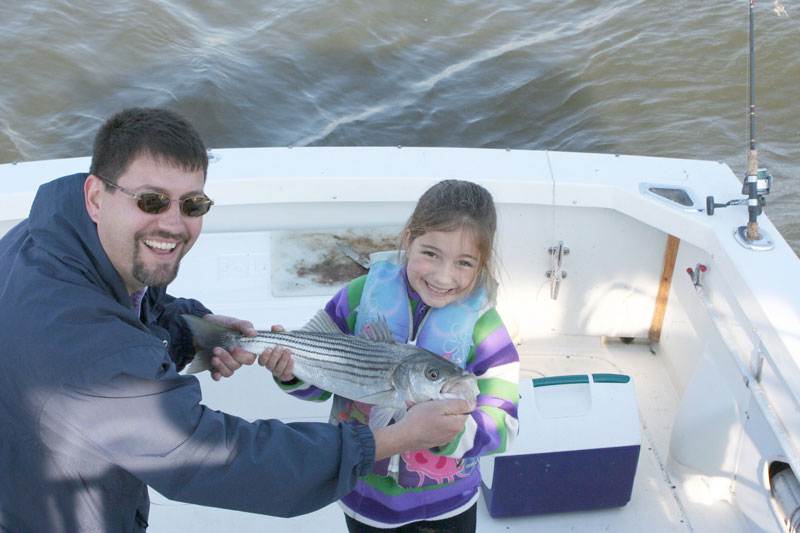When warm weather moves in and stripers school up there’s no doubt that one of the most effective way to catch fish in large numbers is often chumming, but chumming in the summer is a bit different than late season chumming for stripers. The tactic isn’t complex but altering it a bit to match up with the fish’s behavior during the mid-summer months is necessary, if you want to put dinner in the cooler. Use these tactics to heat up your summer fishing.

Where to Chum in the Summer
While specific hot zones vary from season to season, there are some consistent factors you should take into account when choosing a specific chumming spot. Most importantly, you need to anchor over structure and boat positioning is paramount. The schoolie stripers will usually be holding tight to cover, and to effectively chum for them you’ll want to find a hump, ledge, trough or bar and anchor on the up-current side. By anchoring up-current, the tide will sweep your chum line over and around the structure.
In some cases chumming for schoolies will put you in competition with a large number of boats, all putting out their own chum lines. Particularly at popular spots within shooting distance of major metropolitan areas, things can get a bit tight – you may see 100-plus boats all anchored up close together. There are a few ways to deal with this type of situation. First off, you can simply go somewhere else. If that’s not an acceptable option, you can leave the dock before sunrise. Few anglers will arrive before 7:00 a.m. and the bulk of the pack usually rolls in between 8 a.m. and 9:00. Most importantly, however, if you’re forced to join an already-present pack of chummers make sure you set up down-current of the pack. This will enable you to take advantage of the tail end of the packs’ chum as it drifts back and away from the fleet. Anchor up-current, and you set yourself up for a losing battle with 100 other boat’s chum slicks.
One other consideration when choosing a summer chumming spot is the presence of the “dead zone.” This anoxic water usually sits in the deep areas of the bay, from 30’ or 35’ down. Note that while the dead zone prevents fish from hanging deep, they naturally want to go deep to find cooler water. Thus, fish can often be found just a foot or two above the dead zone. Whenever you can locate structure that intersects with the water just above the dead zone, you have a good shot at finding fish.
Last season, the ledges off Tolchester, Love Point, and Podickory were the hottest spots around, followed by the drop-offs in the Potomac from Tall Timbers to St. George’s Island. Hollicutts Noose in Eastern Bay and The Diamonds off the Choptank also had periods of decent action. Which spot will be the top choice, right now? We have to work on these articles ahead of time and I’ve always found that when it comes to fishing, making predictions is an excellent method of inserting my foot directly into my mouth. So I’ll do like usual, and recommend that everyone reading this right now check out our current fishing reports, updated every Friday by noon.

How to Summer Chum
This is how most people chum, and it does work: They hang a chum bag or bucket at the surface, and set out a line with little or no weight 30- to 50-feet back. A second line goes out with a half-ounce of weight, and is set the same distance back just below surface. A third one gets an ounce and hangs at mid-depth, and a forth line is rigged with enough weight to stay at or near the bottom. All four rods are placed in holders, and the anglers sit while they wait for a strike. This is simple and somewhat effective, but also somewhat lazy fishing. If you want to boost your catch rate, use these two tricks:
Trick number one: Do not set your surface line. Instead, put the reel in freespool, and dangle the bait right next to the chum bucket. Now give a few tugs on the buckets’ rope, so a nice cloud of chum flows out. At the same time, release all tension on your surface bait and allow it to drift back and sink naturally, in that cloud of chum. Strip line from your reel and keep it slack, so the bait is not pulled out of the chum cloud by tension on the line. Watch the slack line as your bait moves back, and when you see the line jerk or suddenly change direction, s-l-o-w-l-y apply tension and allow the circle hook to do its thing. If nothing strikes after you’ve drifted the bait back 100’ or so, reel in and start over.
Trick number two: As you probably know already, larger fish will often come from baits set on bottom. You should also know that in order to effectively fish the bottom you’ll need weight, and if you set a rod untended in the holder, you won’t be able to feed fish line upon the initial bite. Fish that strike the bottom line are therefore likely to feel that weight and dump the bait. You can fix this problem, however, at least when the current is moving. Use an egg sinker or fishfinder rig, larger than necessary to hold bottom. I like to use at least three ounces for this purpose, and in a stiff current four is better. Set it on bottom, then sweep your rod tip forward as you let out line. Apply minimum tension on the line, and let your tip go back slowly. The current will pull on your bait, and take line out through the egg sinker. (This is why you want an oversized weight; smaller sinkers will get pushed back by the current.) Repeat the process two or three times until you have let 10- to 15-feet of line out through the egg sinker. This extra line out beyond the sinker allows the fish to swim for several seconds before feeling any unusual resistance.
Chumming Rigs & Baits
Rigging and baiting for summer chumming is an exercise in simplicity. Just use a four- to five-foot length of 30-pound test leader with an 10/0 or 12/0 circle hook, tied off on a ball-bearing swivel. Spinning or conventional gear in the 10- to 20-pound class matches up well against these fish.
One important detail (which some folks are sure to disagree with me on) is to use monofilament, not braid, when chumming. Superlines are great for some situations, but IMHO chumming is not one of them. Their greatly enhanced sensitivity means the fish feel something’s odd and by my calculations, spit the baits twice as often. That comes after an entire season of fishing mono on one half the boat and braid on the other, and recording a two-to-one catch rate – make of it what you will.
Casting chum rigs is another mistake you see people make all the time. There’s no better way to quickly get your bait far away from the chum line (and the fish) than by casting. What about using razor clams, or other popular non-menhaden baits? This works sometimes, but a nice, fresh chunk of menhaden is tough to beat in a menhaden chum line.
Baits should be matchbook-size, check all baits to make sure they aren’t spinning before you lower them to the bottom, and remember that with circle hooks you want as much of the hook exposed as possible and the point absolutely, positively must be completely exposed. Also remember to wait for the fish to set the hook itself, and apply tension as slowly as possible. Truth be told, the most effective way to use circle hooks is, for most anglers, to leave rods in the holders with live-liners set for minimal tension, and not to so much as touch anything until the rod bends all the way over.
BUT REMEMBER: Heat Kills
Don’t forget that once water temperature exceeds 70-degrees, catch-and-release mortality of striped bass increases significantly. If you’re encountering hordes of throw-backs while summer chumming, the right thing to do is pull the anchor and try a different spot. And once you’ve caught as many stripers as you plan on keeping, move on to targeting another species to avoid catch and release mortality. Also, not the hook size recommendation above; smaller circle hooks do tend to get swallowed all the way down and though a 12/0 seems outrageously large for schoolies, keepers-sized fish have zero problem grabbing them. If you’re not up to date on the best practices for releasing fish safely, be sure to review read the Dos and Don’ts of Catch and Release Fishing for a refresher.
Now, put your head down next to the chum bucket, and inhale deeply. That’s the smell of summer chumming – ahhhhhh, yummy. And when you’re fishing for schoolie stripers in the Chesapeake, it’s also the smell of success.